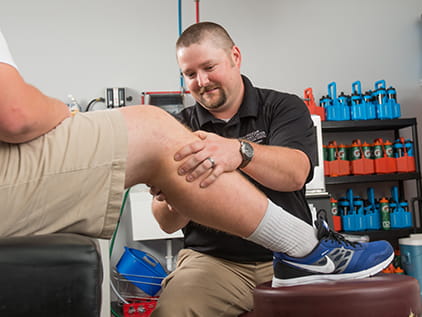Sudden Cardiac Death in Young Athletes
Discussions about the dangerous effects of concussions in young athletes have gained national attention. But another threatening condition is equally deserving of coverage: sudden cardiac arrest.
The American Academy of Pediatrics estimates that approximately 2,000 people under the age of 25 die from sudden cardiac arrest in the U.S. each year. It is the leading cause of death in young athletes in the United States – resulting in 1 death in a high school student every 3 days, according to some experts.
In contrast, the Centers for Disease Control reports 1.5 deaths per year due to sports concussions.
“There’s no question that concussions can cause very serious, life-changing damage. But thankfully, it’s not unusual for someone to survive a concussion,” says Ashley Simmons, MD, cardiologist and medical director of the women’s heart health program at The University of Kansas Health System. “Surviving sudden cardiac arrest, on the other hand, is rare.”
What is it?
Sudden cardiac arrest is commonly confused with a heart attack, but they are different conditions. Heart attacks are caused by blockages in the heart that prevent normal blood flow. Heart attack symptoms can appear suddenly, but they more often begin hours, days or weeks before a heart attack.
Sudden cardiac arrest, on the other hand, usually happens immediately and without warning. It occurs when the heart beats irregularly, causing the heart to malfunction and stop beating unexpectedly.
“Without immediate medical intervention, sudden cardiac arrest can very quickly lead to death in just a few minutes,” says Dr. Simmons. “Cardiac arrest can be treated quickly with a defibrillator if it is addressed promptly.”
Causes of sudden cardiac arrest
Undiagnosed, preexisting heart conditions are typically responsible for sudden cardiac arrest. They may include a structural defect, such as coronary artery abnormalities, or a problem with the heart’s electrical system, like ventricular fibrillation.
A condition known as hypertrophic cardiomyopathy, or HCM, is the most common cause of sudden cardiac death in young people, accounting for about 40% of all cases. HCM occurs when the heart muscle becomes too thick for blood to pump efficiently. This may be due to a genetic defect, aging or another unknown factor. There are usually few warning signs of HCM, and most physicians don’t check for this condition unless family history or another red flag warrants testing.
Prevention and screening
Determining the best course of action to prevent sudden cardiac arrest is a touchy topic. Some health officials insist that schools implement more thorough screening processes for athletes, such as including an electrocardiogram as part of the school’s pre-participation exam (which usually only includes a standard physical and discussion of family history). However, doing so would come with a cost and may result in false-positive readings, causing unnecessary alarm and additional testing.
Another idea is to add automatic external defibrillators, or AEDs, in every school and at sports games. AEDs are machines that shock the heart and restore normal rhythm. A study from the New England Journal of Medicine found that communities with comprehensive AED programs that include CPR and AED training for rescuers have achieved survival rates of nearly 40 percent for cardiac arrest victims.
Safety first
Although sudden cardiac arrest is a real threat that parents should be aware of, it does not have to prevent kids from participating in the activities they love. Parents of young athletes can protect their children by staying informed, taking precautions and recognizing when there’s a problem.
“Know the warning signs and be prepared,” says Dr. Simmons. “Talk to your child’s physician about additional testing if you have a family history of early cardiac death. Also, consider registering for a CPR or AED training course so you know how to respond in an emergency.”





